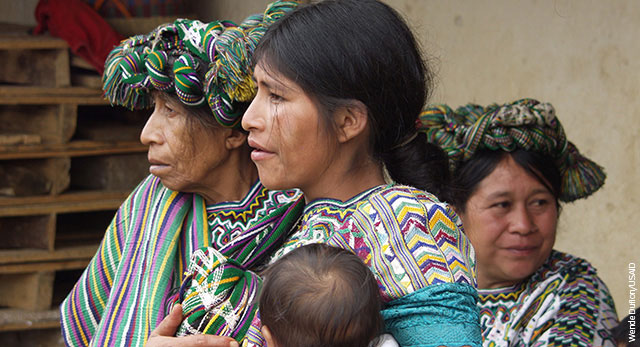
Guatemala faces alarming levels of chronic malnutrition, which manifests as childhood stunting. Half of boys and girls between 3 and 59 months of age are stunted. Chronic and other forms of malnutrition not only compromise the health and well-being of Guatemala’s women and children but also impede the country’s economic development through lost productivity.
The Government of Guatemala has made addressing chronic malnutrition a priority and is committed to reducing chronic malnutrition by 24% by 2021. The Ministry of Public Health and Social Welfare (MSPAS in Spanish) identified a package of nine essential nutrition-specific and nutrition-sensitive interventions that should be implemented at scale to achieve this goal. Resource allocation for these interventions must be planned following the government’s Results-Based Budget Management Agreement, which links budget allocations to performance-based outcome indicators—in this case, effective delivery of health and nutrition services to improve nutrition outcomes. Results-based budget management is a component of results-based management, which has been adopted by the public sector in several countries to increase the transparency and accountability of government services.
To help Guatemala plan and budget for the nutrition services, FANTA and the Central American Institute of Fiscal Studies (ICEFI in Spanish) collaborated with MSPAS and the Ministry of Public Finances (Minfin) to determine the costs of implementing the nine interventions nationally and in each of the 10 departments prioritized by the Government due to their high levels of chronic malnutrition, including the Western Highlands, where USAID is supporting the Government’s efforts to reduce stunting. The costing exercise used the activity-based costing methodology (ABC), marking its first use in Guatemala. Broadly, the ABC methodology estimates the cost of a program by costing each of the activities (interventions, or cost centers) within the program. For example, to determine the costs of antenatal care, ABC would capture the costs of staff time, distribution of iron-folate tablets, and acquisition and maintenance of equipment such as weighing scales and other items.
To conduct the exercise, data were collected from a sample of first- and second-level health care facilities (e.g., health posts and health centers) managed by different entities (e.g., MSPAS, nongovernmental organizations, or others) and in areas with varying levels of chronic malnutrition. Unit costs by intervention were calculated to estimate the total cost of providing nutrition services at the current level of coverage for each intervention for one year. Cost estimates were then projected for expanding coverage over the period of 2013–2021 to reach all eligible women and children, based on population projections and taking into account current levels of coverage for each intervention. The government’s projected budget for nutrition for the 2013–2021 period was then compared with the cost estimates calculated from the costing exercise to estimate the gap in funding or investment required to strengthen nutrition service delivery and increase coverage between 2013 and 2021.
Results from the costing exercise showed that nutrition was severely underfunded in Guatemala. For example, in 2013, the government invested 637.2 million quetzals (about US$80 million) in nutrition, only about a third of the 1.8 billion quetzals (about US$230 million) required for that year. The results also showed that if the government continues to increase its nutrition budget by only 5% a year, the nutrition investment gap could reach nearly 3 billion quetzals (about US$380 million) by 2021. Based on these results, several recommendations were provided for increasing investment in nutrition as well as in the health sector overall, promoting policies that support nutrition, and strengthening nutrition programming.
The results from the exercise are helping to raise awareness among key government stakeholders of the consequences of malnutrition for Guatemala and the need to increase investment in nutrition. Minfin took a leading role in conducting the costing exercise, which deepened the ministry’s commitment to and understanding of the importance of investing in nutrition and made it an influential champion for nutrition given its key role in preparing the national budget for approval by the Guatemalan parliament. Moreover, data from the costing exercise were used in advocacy materials that FANTA developed to help government officials and civil society groups promote investment in nutrition.
The work that was done is also contributing to government officials’ capacity to better plan and budget for nutrition. The recommendations provided include provisions for improving the government’s health system, allocating financial and human resources for effective nutrition service delivery at scale to meet the commitments and performance indicators outlined in the Results-Based Budget Management Agreement, and ensuring financial transparency. In addition, FANTA trained key Minfin officials in the ABC methodology and collaborated with the government to develop an ABC manual.
The costing exercise is of interest outside Guatemala as well. This is due to the growing interest in nutrition costing sparked by initiatives such as the Scaling Up Nutrition movement that promote adequate, sustainable funding for nutrition. FANTA has presented the costing exercise’s results at international conferences exploring gaps in nutrition investments, contributing to a global dialogue that will help promote and improve nutrition costing in developing countries and could lead to greater investment in nutrition to improve nutrition service delivery.


